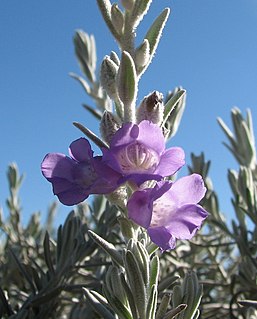
Eremophila nivea, commonly known as silky eremophila, is a flowering plant in the figwort family, Scrophulariaceae and is endemic to Western Australia. In nature it is a rare shrub with hairy branches and leaves, and blue, purple or violet flowers.

Eremophila densifolia is a flowering plant in the figwort family, Scrophulariaceae and is endemic to the south-west of Western Australia. It is usually a low, spreading shrub with densely clustered leaves and lilac to purple flowers.

Eremophila enata is a flowering plant in the figwort family, Scrophulariaceae and is endemic to central areas of Western Australia. It is a low, spreading shrub with serrated leaves and purplish to pinkish flowers.
Eremophila grandiflora is a flowering plant in the figwort family, Scrophulariaceae and is endemic to Western Australia. It is a large shrub with shiny leaves and the largest flowers in its genus and is only known from a restricted area near Paynes Find.
Eremophila lanata is a flowering plant in the figwort family, Scrophulariaceae and is endemic to Western Australia. It is a small shrub with small, hairy leaves, densely hairy sepals and lilac to pinkish flowers.
Eremophila pendulina is a flowering plant in the figwort family, Scrophulariaceae and is endemic to Western Australia. It is a tall, spindly, weeping shrub with narrow leaves and purple, mauve or white flowers in autumn and early spring.
Eremophila retropila is a flowering plant in the figwort family, Scrophulariaceae and is endemic to Western Australia. It is an erect, spreading shrub with hairy, greyish leaves crowded at the ends of the branches, and lilac or violet-coloured flowers which are white inside.
Eremophila simulans is a flowering plant in the figwort family, Scrophulariaceae and is endemic to Western Australia. It is an erect shrub with broad, serrated leaves and violet to purple flowers.
Eremophila ballythunnensis is a flowering plant in the figwort family, Scrophulariaceae and is endemic to Western Australia. It is a small, spreading shrub with narrow oval leaves and mauve-purple flowers with densely hairy sepals.
Eremophila capricornica is a flowering plant in the figwort family, Scrophulariaceae and is endemic to Western Australia. It is a small shrub with woolly branches, grey, hairy leaves and mauve to lilac-coloured flowers with hairy sepals.
Eremophila daddii is a flowering plant in the figwort family, Scrophulariaceae and is endemic to Western Australia. It is a large shrub with sticky branches, hairy leaves and brown and cream-coloured flowers blotched with purple.
Eremophila ferricola is a flowering plant in the figwort family, Scrophulariaceae and is endemic to Western Australia. It is an erect shrub with lance-shaped leaves and yellowish brown to greenish yellow flowers covered with fine hairs. The species is only known from a single location, growing on a banded ironstone hill.
Eremophila hamulata is a flowering plant in the figwort family, Scrophulariaceae and is endemic to Western Australia. It is an erect, woody shrub with sticky branches, narrow, hooked leaves and hairy mauve-purple flowers.
Eremophila jamesiorum is a flowering plant in the figwort family, Scrophulariaceae and is endemic to Western Australia. It is a wispy, sticky shrub with narrow linear leaves and white flowers tinged with pink or mauve. It is only known from a few locations in the Gibson Desert.
Eremophila pusilliflora is a flowering plant in the figwort family, Scrophulariaceae and is endemic to Western Australia. It is a low, open shrub with narrow egg-shaped leaves and flowers which vary in colour from red to cream with a red tinge. It grows in the Pilbara region.
Eremophila laccata is a flowering plant in the figwort family, Scrophulariaceae and is endemic to an area near Carnegie in Western Australia. It is a small, low, spindly shrub with scattered, linear leaves, and pink, flattened bell-shaped flowers.
Eremophila regia is low-growing shrub with pink to red flowers, small thread-like leaves and that is endemic to Western Australia. It grows on rocky hilltops in the Princess Ranges.
Eremophila scrobiculata is low, spreading shrub with sessile, linear leaves and lilac-coloured flowers and that is endemic to Western Australia. It grows on the slopes of low, stony hills on Wanna Station.
Eremophila victoriae is small shrub with sessile, egg-shaped leaves and purple flowers and that is endemic to Western Australia. It is only known from two populations in the Great Victoria Desert.
Eremophila yinnetharrensis is a species of flowering plant in the family Scrophulariaceae and is endemic to a restricted area of Western Australia. It is an erect, wispy shrub with sessile, lance-shaped leaves with the narrower end towards the base and purple flowers. It is only known from near Yinnetharra Station in the Gascoyne region.



